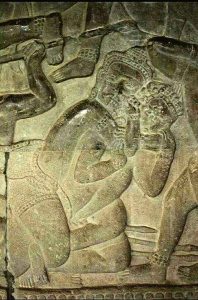The rear naked choke is one of the most fundamental submissions in both BJJ and MMA, to the point that it’s often one of the first that a new starter might learn. It’s so essential in fact that it is the single-most common submission used in the UFC and accounts for more than double the amount of finishes as any other submission in history (up to the end of 2019). This trend actually began at the very first UFC event, there being a total of five different submission finishes at UFC 1 (four legitimate submission techniques) and two of these finishes were rear naked chokes. While every solid grappler will likely register at least one finish this way, most Jiu-Jitsu experts are absolutely lethal from the back in MMA and it shows in their competitive records. Demian Maia has 9 out of 12 submission finishes via rear naked choke, Gunnar Nelson has 6 out of 12 and Charles Oliveira has 7 out of 19 at the time of writing.
It has often been referred to as the “Mata Leao” in Brazil (Lion Killer in Portuguese), but the submission does not originate in Brazil and the clue to it’s origins lies in the English name. The “naked” refers to the fact that the choke is performed without the use of the opponent’s gi, it being translated from the traditional Japanese name that was used in Judo, “Hadaka Jime”. Interestingly though, the Japanese name makes no distinction between the traditional rear naked choke grip, and the modified palm-to-palm grip that is sometimes used. Due to the widespread usage of this technique, it’s virtually impossible to trace it back to a single practitioner and it’s highly likely that it was taught and used in the early days of Judo with Kano Jigoro and Mitsuyo Maeda before the latter made his way to Brazil, potentially even dating back to the very beginnings of JuJutsu.
It seems as though the Japanese Martial Arts do not have a monopoly on the technique however, as an ancient Cambodian Bas Releif appears to depict not only a rear naked choke, but one with the attacker’s legs controlling his opponent’s body too. It’s a little unclear whether the leg configuration appears to be a traditional hooks-in approach, or something similar to a full Body Triangle. The Bas Releif itself is actually one of many that portrays the Cambodian form of Folkstyle Wrestling known as Khmer Traditional Wrestling. Although this specific carving’s dating is unknown, the sport itself dates as far back as the 8th Century AD and has it’s origins in a similar style of wrestling that was known as Maloyuth, and was created in 788 AD.

As with our research into the origins of the heelhook, it appears as though the rear naked choke actually finds it’s earliest beginnings in Pankration, all the way back in Ancient Greece. The submission appears in the historical accounts of the 54th Olympiad in 564 BC, where the returning champion Arrhichion would go on to secure his third consecutive victory over a field of competitors. Although, it wasn’t actually Arrhichion who used the rear naked choke at all. In fact, he was actually choked to death in his final match against a Pankratiast who’s name has sadly been lost to time.
There are two surviving accounts of what was quite possibly the most bizarre combat sports match in history, from a Geographer, Pausanius, and a Sophist (Philosophical Teacher) Philostratus the Younger. Both men seem to agree on the general course of events that led to a dead man being awarded an olive wreath and the title of champion. It appears that the unnamed competitor had managed to get behind Arrhichion and had “wound his forearm about the other’s throat to shut off the breathing, while pressing his legs on the groins and winding his feet one inside each knee of his adversary.”

So how did Arrhichion win? Well it seems that he actually used something that every white belt has been caught with at some point, the ankle-lock counter to when your back is taken:
“But in relaxing the tension of his legs he failed to forestall the scheme of Arrichion; for the latter kicked back with the sole of his right foot (as the result of which his right side was imperiled since now his knee was hanging unsupported), then with his groin he holds his adversary tight till he can no longer resist, and, throwing his weight down toward the left while he locks the latter’s foot tightly inside his own knee, by this violent outward thrust he wrenches the ankle from its socket”
This breaking of the ankle is what led to Arrhichion’s opponent submitting at the exact moment that he was actually choked to death. Another Greek Sophist, Philostratus of Athens, claimed that the reason Arrhichion chose death and victory over life and submitting to defeat was actually thanks to his trainer, Eryxias. He shouted “What a noble epitaph: He was never defeated at Olympia!” and to a certain extent, he was right. To this day, Arrhichion is often regarded as the most famous of all Pankratiasts and is the only recorded victor of three consecutive Olympiads, dominating the sport for twelve years, until the very day he died.
This piece is part of a series diving deep into the history of various submissions, click here to look through the rest of the series.













